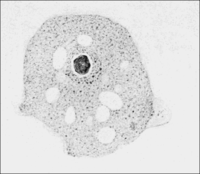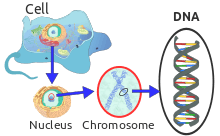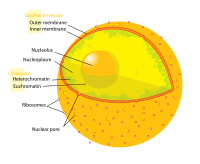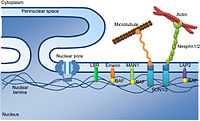Eukaryotes

"A eukaryote is an organism whose cells contain complex structures enclosed within membranes. The defining membrane-bound structure that sets eukaryotic cells apart from prokaryotic cells is the nucleus, or nuclear envelope, within which the genetic material is carried.[1][2][3]"[4]
Theory of eukaryotes

Def. "[a]ny of the single-celled or multicellular organisms whose cells contain at least one distinct nucleus"[5] is called a eukaryote.
Nuclear envelopes

"A nuclear membrane (also known as the nuclear envelope, nucleolemma or karyotheca) is a double lipid bilayer that encloses the genetic material in eukaryotic cells. The nuclear membrane also serves as the physical barrier, separating the contents of the nucleus (DNA in particular) from the cytoplasm. Many nuclear pores are inserted in the nuclear envelope, which facilitate and regulate the exchange of materials (proteins such as transcription factors, and RNA) between the nucleus and the cytoplasm."[6]
Perinuclear spaces

The perinuclear space (PNS) is the space between the inner and outer nuclear membranes (lipid bilayers). The PNS is joined with the lumen of the rough endoplasmic reticulun (RER). The width of the PNS is about 20 - 40 nm. The perinulcear space is also called the perinuclear cisterna or nuclear envelope lumen.
The diagram at right indicates the various molecular structures of or associated with the nuclear envelope.
Nuclear pore complexes

"There are about an average of 2000 nuclear pore complexes (NPCs), in the nuclear envelope of a vertebrate cell, but it varies depending on cell type and the stage in the life cycle. The proteins that make up the nuclear pore complex are known as nucleoporins. About half of the nucleoporins typically contain either an alpha solenoid or a beta-propeller fold, or in some cases both as separate structural domains. Each NPC contains at least 456 individual protein molecules and is composed of 30 distinct proteins (nucleoporins).[7]"[8]
Research
Hypothesis:
- There organisms between prokaryotes and eukaryotes that have nuclei somewhat separated from cellular cytoplasm.
Control groups

The findings demonstrate a statistically systematic change from the status quo or the control group.
“In the design of experiments, treatments [or special properties or characteristics] are applied to [or observed in] experimental units in the treatment group(s).[9] In comparative experiments, members of the complementary group, the control group, receive either no treatment or a standard treatment.[10]"[11]
Proof of concept
Def. a “short and/or incomplete realization of a certain method or idea to demonstrate its feasibility"[12] is called a proof of concept.
Def. evidence that demonstrates that a concept is possible is called proof of concept.
The proof-of-concept structure consists of
- background,
- procedures,
- findings, and
- interpretation.[13]
See also
References
- ↑ Robert M. Youngson (2006). Collins Dictionary of Human Biology. Glasgow: HarperCollins. ISBN 0-00-722134-7.
- ↑ David L. Nelson, Michael M. Cox (2005). Lehninger Principles of Biochemistry (4th ed.). New York: W.H. Freeman. ISBN 0-7167-4339-6.
- ↑ Martin, E.A., ed (1983). Macmillan Dictionary of Life Sciences (2nd ed.). London: Macmillan Press. ISBN 0-333-34867-2.
- ↑ "Eukaryote, In: Wikipedia". San Francisco, California: Wikimedia Foundation, Inc. October 24, 2012. Retrieved 2012-10-27.
- ↑ "eukaryote, In: Wiktionary". San Francisco, California: Wikimedia Foundation, Inc. October 16, 2012. Retrieved 2012-10-27.
- ↑ "Nuclear membrane, In: Wikipedia". San Francisco, California: Wikimedia Foundation, Inc. October 23, 2012. Retrieved 2012-10-27.
- ↑ M. P. Rout (2000). "The yeast nuclear pore complex: composition, architecture, and transport mechanism". J. Cell Biol. 148 (4): 635–652. doi:10.1083/jcb.148.4.635. PMID 10684247.
- ↑ "Nuclear pore, In: Wikipedia". San Francisco, California: Wikimedia Foundation, Inc. October 27, 2012. Retrieved 2012-10-27.
- ↑ Klaus Hinkelmann, Oscar Kempthorne (2008). Design and Analysis of Experiments, Volume I: Introduction to Experimental Design (2nd ed.). Wiley. ISBN 978-0-471-72756-9. http://books.google.com/?id=T3wWj2kVYZgC&printsec=frontcover.
- ↑ R. A. Bailey (2008). Design of comparative experiments. Cambridge University Press. ISBN 978-0-521-68357-9. http://www.cambridge.org/uk/catalogue/catalogue.asp?isbn=9780521683579.
- ↑ "Treatment and control groups, In: Wikipedia". San Francisco, California: Wikimedia Foundation, Inc. May 18, 2012. Retrieved 2012-05-31.
- ↑ "proof of concept, In: Wiktionary". San Francisco, California: Wikimedia Foundation, Inc. November 10, 2012. Retrieved 2013-01-13.
- ↑ Ginger Lehrman and Ian B Hogue, Sarah Palmer, Cheryl Jennings, Celsa A Spina, Ann Wiegand, Alan L Landay, Robert W Coombs, Douglas D Richman, John W Mellors, John M Coffin, Ronald J Bosch, David M Margolis (August 13, 2005). "Depletion of latent HIV-1 infection in vivo: a proof-of-concept study". Lancet 366 (9485): 549-55. doi:10.1016/S0140-6736(05)67098-5. http://www.ncbi.nlm.nih.gov/pmc/articles/PMC1894952/. Retrieved 2012-05-09.
External links
- African Journals Online
- Bing Advanced search
- GenomeNet KEGG database
- Google Books
- Google scholar Advanced Scholar Search
- Home - Gene - NCBI
- JSTOR
- Lycos search
- NCBI All Databases Search
- Office of Scientific & Technical Information
- PsycNET
- PubChem Public Chemical Database
- Questia - The Online Library of Books and Journals
- SAGE journals online
- Scirus for scientific information only advanced search
- SpringerLink
- Taylor & Francis Online
- WikiDoc The Living Textbook of Medicine
- Wiley Online Library Advanced Search
- Yahoo Advanced Web Search
| |||||||||||||||||||||||||||||||||||
| |||||||||||||||||||||||||||||||||||||||||
| |||||||||||||||||||||||||||||||||||
![]() This is a research project at http://en.wikiversity.org
This is a research project at http://en.wikiversity.org
| |
Development status: this resource is experimental in nature. |
| |
Educational level: this is a research resource. |
| |
Resource type: this resource is an article. |
| |
Resource type: this resource contains a lecture or lecture notes. |
| |
Subject classification: this is a biochemistry resource. |